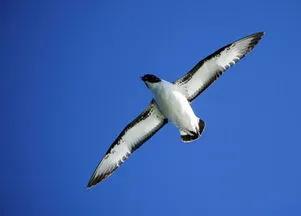albatross
In the past, superstitious sailors regarded albatrosses as the reappearance of the undead of their companions who were unfortunate enough to be buried in the sea, and were convinced that killing an albatross would bring misfortune. Samuel Taylor Coleridge's famous poem", The Poetry of the Ancient Sailor, recounts a story of how disaster struck a ship after an albatross was shot. Even so, however, many 19th-century sailors were keen to prey on this bird to enrich the tedious diet of the long voyage, folding their feet into cigarette bags and placing the bones of their wings into pipes. The word albatross evolved from the Portuguese word "alcatraz" and was originally used to refer to any kind of large seabird, and it is clear that this Portuguese word is derived from the Arabic word "al-cadous", which refers to pelicans.

Albatross differs from other birds of this order (Ploveridae) in that their tubular outer nostrils are located on both sides of the beak base rather than converging on top of the beak base. There are 4 genera under the family Albatross: "Diomedea", or "Albatross the Great", consisting of 6 species with an average wingspan of up to 3 m;
"Thalassarche" genus, with 9 relatively small species, is often referred to as "mollymauks" (derived from the Dutch word "mollemok", originally referred to as stinky gull); The genus "Phoebastria" includes 4 species from the North Pacific and Tropical Pacific regions. The genus "Phoebetria", consisting of a dark-bodied Uxatross and a grey-backed albatross, has relatively long wings. Through molecular analysis in recent years, the number of recognized albatross species has increased from 14 to 21.
The type of albatross representative
1. An immature black-browed albatross flying; 2. A pair of Kashima albatrosses showing off in courtship; 3. A gray-backed albatross and its chicks; 4. A wandering albatross and its chicks, which can consume 65 kg of food during the period of rearing.
Gliding champion
Form and function
Albatrosses are known for flying effortlessly. They are able to glide with the boat for hours without flapping their wings. One of their adaptability to reduce muscle energy consumption when gliding is that they have a special tendon that holds the extended wings in place.
The second is the astonishing length of the wings, compared to birds of other families of the Order, the albatross (mainly on the islands off the coast of Japan and Taiwan), the black-footed albatross of the northwest Pacific Ocean, and the black-backed albatross of the Hawaiian Islands all breed in the North Pacific. Today, there are no albatrosses breeding in the North Atlantic, and although there was during the Pleistocene 1.8 million to 10,000 years ago, it is known that a few of those who strayed into the North Atlantic have survived for decades. The reason why there are no populations of albatrosses in the North Atlantic today is most likely that the post-Pleistocene proliferation did not occur there.
Dependent on the ocean
food
It is not difficult to know from the habit of following ships that albatrosses are notorious scavengers who like to eat the waste thrown from ships. Their diet range is extensive, but a detailed analysis of the components of their stomachs has found that fish, squid, and crustaceans constitute the main food source of albatrosses. They prey on these animals mainly on the surface of the sea, but occasionally burrow into the water like, reaching depths of up to 6 meters (gray-headed albatrosses) and even as deep as 12 meters (gray-backed albatrosses).
Albatrosses sometimes forage at night, when a lot of marine organic matter floats to the surface. Regarding the proportion of albatrosses foraging during the day and night, more information can be obtained by having them swallow a sensor. The sensor is located in the stomach, and when an albatross swallows a fish caught from the cold waters of the Southern Ocean, the temperature in the body immediately drops, and the sensor records this. The proportion of food ingredients ingested varies from species to species, and this has a large impact on the reproductive biology of albatrosses.
During the breeding season, albatrosses (as shown in this picture) join forces to perform courtship rituals, such as dancing a strange ballet-like dance, with bowing, plowing, beaking, nasal sounds, and other movements.